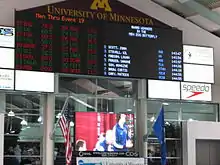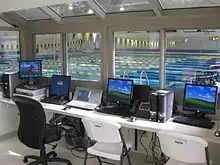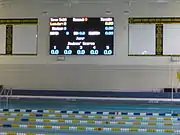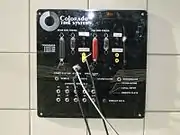Aquatic timing system
Aquatic timing systems are designed to automate the process of timing, judging, and scoring in competitive swimming and other aquatic sports, including diving, water polo, and synchronised swimming. These systems are also used in the training of athletes, and many add-on products have been developed to assist with the training process.


Manufacturers
Manufacturers and Operating Areas:
- Colorado Time Systems - Worldwide
- Swiss Timing (Omega) - Worldwide
- Daktronics - USA
- International Swimming Timing - USA
- Superior Swim Timing - USA
- Stramatel - Europe
- Macsha Timing - Europe
- Seiko - Asia
History
Prior to the 1950s, competitive swimmers relied on the sound of a starting pistol to start their races and mechanical stopwatches to record their times at the end of a race. A limitation of analog timekeeping was the technology's inability to reliably record times accurately below one tenth (0.1) of a second.[1]
In 1967, the Omega company of Switzerland developed the first electronic timing system for swimming that attempted to coordinate the physical the recorded time. This new system placed contact pads (known as touch pads) in each lane of the pool, calibrated in such a fashion that the incidental water movement of the competitors or wave action did not trigger the pad sensors; the pad was only activated by the touch of the swimmer at the end of the race.[2]
- Image Gallery
 Olympex display at the Grosse Pointe Yacht Club
Olympex display at the Grosse Pointe Yacht Club Diving template on an Olympex Display
Diving template on an Olympex Display Colorado Time Systems wallplate
Colorado Time Systems wallplate
Swimming Meet Manager
Swimming Meet Manager are programs created to automate the process of generating results and can be either downloadable or web applications. They are normally sold to clubs and can also be connected to the timing system to obtain timing information automatically. See some of the most used programs:
- Hy-Tek Meet Manager (Worldwide)
- Geologix Splash Software (Europe)
- SwimTopia (USA)
- TeamUnify (USA)
- Bigmidia - Sge (Brazil)
- Swim It Up! - MM (Brazil)
See also
References
- "Swimming Timing". Omega Timing. Archived from the original on
|archive-url=requires|archive-date=(help). - "Swimming Timing | Encyclopedia.com". www.encyclopedia.com. Retrieved 2021-01-11.
| Wikimedia Commons has media related to Sports scoreboards. |
